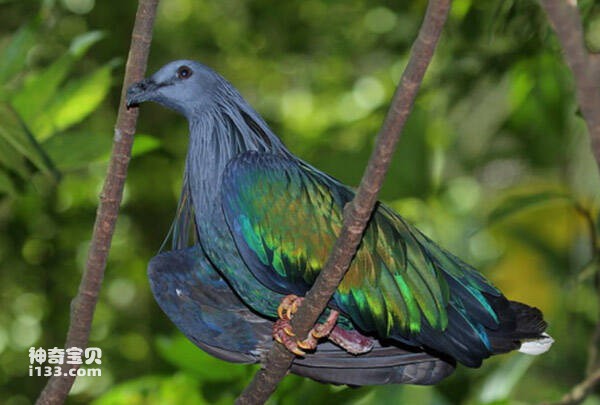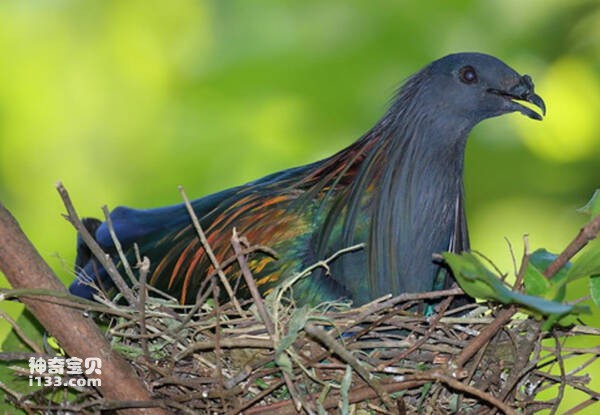Caloenas nicobarica
IUCN
LCBasic Information
Scientific classification
- name:Caloenas nicobarica
- Scientific Name:Caloenas nicobarica,Nicobar Pigeon,Nicobar Dove,Paloma de Nicobar
- Outline:Landfowl
- Family:
Vital signs
- length:32-38cm
- Weight:460-600g
- lifetime:No textual research information is available
Feature
It is stocky and has a distinctive long bark on its neck
Distribution and Habitat
It is found in Cambodia, India, Indonesia, Malaysia, Myanmar, Palau, Papua New Guinea, Philippines, Solomon Islands, Thailand, Timor-Leste, and Vietnam.
It inhabits tropical rainforests, dry forests, mangroves and shrubs. Occurs only on small wooded islands, which are generally uninhabited and have relatively intact forest cover over large land areas; Live in mangrove, scrub, lowland and piedmont forests at elevations of at least 700 meters. In some places, they also live in persistent secondary forest habitats and will be able to adapt to selectively logged forests.
Appearance
The length of the green pigeon is 32-38 cm, the male weighs 460-525 grams, and the female 490-600 grams. The body is stout and dark, with a distinctive long bark on the neck and a short, all-white tail; The feathers on the head and hairy upper neck are dark black-gray with a silver-purple pattern; The upper body is glossy dark green or coppery green; The lower body is dark, iridescent green or green and blue; A large black beak; Legs purple-red, claws yellow or brownish yellow. Females are similar, but have a smaller head, shorter bark and brown underbody. There was almost no difference in appearance among the populations in different distribution areas. Mature green turmitures are fluffy before their white tails develop; The legs and feet are brown.
The adult bird has no hair on its neck, is completely brown-black, and has a black tail, lacking iridescent feathers. The lack of a white tail for a juvenile dove is a sign that the species clearly sees their immaturity - for an adult,
Details
Caloenas nicobarica has two subspecies: Nicobar Pigeon, Nicobar Dove, and Paloma de Nicobar.

A highly wandering bird, the named subspecies was recorded in November 2009 from Ponape, Federated States of Micronesia, 1500 km from the closest known residence of the species (in northeastern Melanesia). Travel between islands to feed on the larger ones, and sometimes even to "mainland" islands, such as New Guinea, which is localized along the coast except in the south. Near Peninsular Malaysia, it only appears on the small islands on the west coast from August and October to April of the following year, and does not seem to exist during the other months. Able to fly long distances over the sea, often in groups. Arrive at the time and place where the trees commonly bear fruit, and then leave.
Green doves are usually found in pairs or alone, often in groups of 20-30, up to 85, during migration. Flying quickly and powerfully, and able to maintain long distances, generally in groups in the early morning and late evening, flying at altitudes of 60 meters or more; The flight profile is distinctive, with a long neck, wide wings and a short tail; When the bird bursts out of the ground, it flaps its wings and flies, landing in the middle or upper layers of the forest. They roost and nest in large groups. They inhabit the interior of the forest at night and descend to the ground at dawn. They also congregate in areas where grain is grown.

The pattern of flight is similar to that of other doves, although groups often fly in multiple or single columns. Their flight is fast, with a regular beat, and occasionally violent flapping of wings, which is characteristic of pigeons in general. Unlike other pigeons, groups tend to fly in single or single rows, rather than in loose flocks. The white tail is the most prominent feature of an adult green termiture, especially when viewed from a distance in the twilight. It can act like a taillight while flying, allowing other green turmitures to pursue other individuals even in the early morning or at dusk. The lack of white tail feathers in the subadults and juveniles of the green turmiture helps to exclude these juveniles from potential breeding targets, breeding competitors, and herd leaders. Gather the birds together as they cross the sea at dawn or dusk.
Green doves are usually silent, but occasionally a harsh croak or bark appears as a "ku-RRAU", a soft purr or coo, and a pig-like purr, some of which may be a very deep, low and reverberating "rrr-rrr-rrr-" rrr..." It can be heard in the breeding area.

The foraging ecoregion is concentrated in small offshore islands, feeding on fruit and shoots or large amounts of fallen seeds. Occasionally they eat invertebrates. The thick-walled gizzards of the green doves are lined with horny plates for grinding large nuts; Because gizzards help grind up hard food, they also ingest grits and stones up to 10 mm in diameter as gastroliths to help digest large seeds.
The breeding season is significantly longer and varies from location to location. On the Bismarck Islands the nest is built in June, and some birds remain there until January; In Andaman and Nicobar it is January - March or April; April-september in Peninsular Malaysia; On Sumba it is May; In mid-March on the Linga Islands, east of Sumatra; Spawning in mid-July on Tingil Island, west of Java; Chicks were seen in November on Palawan island in the southwestern Philippines; From October to March of the following year on a small island near Irian Jaya; Baby doves can be seen in southern Vietnam in August. Nesting in breeding grounds, sometimes mixed with imperial doves, usually on small islands. In undisturbed breeding fields green turmitus may gather in pairs of up to 1000, but it is more common to gather in pairs of 100, for example in Melanesia.

Green doves are monogamous, and the pair mate for life, usually in large groups during breeding. Loose stick nests are usually built in undisturbed locations or in trees below the canopy. The nests are uneven platforms of branches, with an average diameter of 30 cm and a depth of 23 cm; Be placed at an undisturbed distance of 2 metres above the ground or under the canopy of a disturbed site, up to 12 metres; Several nests can be placed in one tree. One oval white egg with a pale blue hue is laid in each clutch, 43-48 mm x 33-34.5 mm, hatched by both sexes for about 2.5 weeks. The hatchlings, which have no down and are jointly cared for by their parents and fed with rich crop milk, take up to a month to develop feathers and become independent at about 3 months of age.
Green turmitures are hunted in large numbers for food, as well as for sand for jewelry. The species is also trapped in local pet markets, but as outlined in CITES Appendix I, commercial international trade is prohibited. Internationally, captive breeding is able to meet the demand for birds in zoos, where such attractive and unusual birds are often seen. Direct use of the species, even illegal trade, may be sustainable on its own; However, its available nesting habitat is decreasing. The small offshore islands it needs are often felled for plantations, destroyed by construction activity, or polluted by nearby industries or ports. In addition, increasing travel introduces predators to more and more breeding grounds, and populations of green turmitures may be driven to these sites, or wiped out completely. Although the bird is widespread and very common in some locales - even on the island of Little Palau, where it remains quite abundant, with an estimated 1,000 adults remaining - its long-term future is increasingly under threat. For these reasons, the IUCN considers green turmitures to be an endangered species.
In 2017, a few individuals were spotted in the Kimberley region of Western Australia, and subadults were caught in the One-arm Point area near Broome. This is the first recorded occurrence of green turmitures on the Australian mainland.
Listed on the IUCN Red List of Threatened Species (IUCN) ver3.1 - Near Threatened (NT) for 2020.
Listed in Appendix I, Appendix II and Appendix III of the Convention on International Trade in Endangered Species of Wild Fauna and Flora (CITES)2019 edition.
Protect wild animals and eliminate wild meat.
Maintaining ecological balance is everyone's responsibility!








